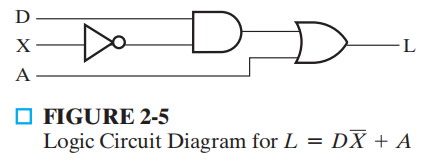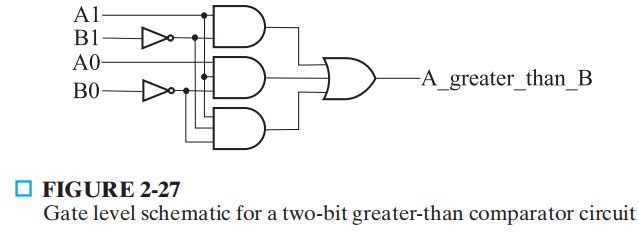Verilog
Chap 2 Combinational Logic Circuits⚓︎

module fig2_5(L, D, X, A);
input D, X, A;
output L;
wire X_n, t2;
not (X_n, X);
and (t2, D, X_n);
or (L, t2, A);
endmodule

// structral model
module comparator_greater_than_structural(A, B, A_greater_than_B);
input [1: 0] A, B;
output A_greater_than_B;
wire B0_n, B1_n, and0_out, and1_out, and2_out;
not
inv0(B0_n, B[0]), inv1(B1_n, B[1]);
and
and0(and0_out, A[1], B1_n);
and1(and1_out, A[1], A[0], B0_n);
and2(and2_out, A[0], B1_n, B0_n);
or
or0(A_greater_than_B, and0_out, and1_out, and2_out);
endmodule
// dataflow model
module comparator_greater_than_dataflow(A, B, A_greater_than_B);
input [1: 0] A, B;
output A_greater_than_B;
wire B0_n, B1_n, and0_out, and1_out, and2_out;
assign B1_n = ~B[1];
assign B0_n = ~B[0];
assign and0_out = A[1] & B1_n;
assign and1_out = A[1] & A[0] & B0_n;
assign and2_out = A[0] & B1_n & B0_n;
assign A_greater_than_B = and0_out | and1_out | and2_out;
endmodule
// conditional model 1
module comparator_greater_than_conditional2(A, B, A_greater_than_B);
input [1: 0] A, B;
output A_greater_than_B;
assign A_greater_than_B = (A > B)? 1'b1 : 1'b0;
endmodule
// conditional model 2
module comparator_greater_than_conditional(A, B, A_greater_than_B);
input [1: 0] A, B;
output A_greater_than_B;
assign A_greater_than_B = (A == 2'b00) ? 1'b0 :
(A == 2'b01)? ~(B[1] | B[0]) :
(A == 2'b10)? ~B[1] :
(A == 2'b11)? ~(B[1]&B[0]) :
1'bx;
endmodule
// behavioral model
module comparator_greater_than_behavioral(A, B, A_greater_than_B);
input [1: 0] A, B;
output A_greater_than_B;
assign A_greater_than_B = A > B;
endmodule
// testbench
module comparator_testbench_verilog();
reg [1: 0] A, B;
wire struct_out;
comparator_greater_than_structural U1(A, B, struct_out);
initial begin
A = 2'b10;
B = 2'b00;
#10;
B = 2'b01;
#10;
B = 2'b10;
#10;
B = 2'b11;
end
endmodule
Chap 3 Combinational Logic Design⚓︎
2-4 译码器
module decoder_2_to_4_v(EN, A0, A1, D0, D1, D2, D3);
input EN, A0, A1;
output D0, D1, D2, D3;
assign D0 = EN & ~A1 & ~A0;
assign D1 = EN & ~A1 & A0;
assign D2 = EN & A1 & ~A0;
assign D3 = EN & A1 & A0;
endmodule;
4-1 多路选择器
module multiplexer_4_to_1_v(S, I, Y);
input [1: 0] S;
input [3: 0] I;
output Y;
assign Y = S[1] ? (S[0] ? I[3] : I[2]) : (S[0] ? I[1] : I[0]);
endmodule
4 位行波加法器
module half_adder_b(x, y, s, c);
input x, y;
output s, c;
assign s = x ^ y;
assign c = x & y;
endmodule;
module full_adder_v(x, y, z, s, c);
input x, y, z;
output s, c;
wire hs, hc, tc;
half_adder_v HA1(x, y, hs, hc), HA2(hs, z, s, tc);
assign c = tc | hc;
endmodule;
module adder_4_v(B, A, C0, S, C4);
input [3: 0] B, A;
input C0;
output [3: 0] S;
output C4;
wire [3: 1] C;
full_adder_V Bit0(B[0], A[0], C0, S[0], C[1]),
Bit1(B[1], A[1], C[1], S[1], C[2]),
Bit2(B[2], A[2], C[2], S[2], C[3]),
Bit3(B[3], A[3], C[3], S[3], C[4]);
// Or just one statement
// assign {C4, S} = A + B + C0;
endmodule
Chap 4 Sequential Circuits⚓︎
正边沿触发器 ( 有复位功能 )
module dff_v(CLK, RESET, D, Q);
input CLK, RESET, D;
output Q;
reg Q;
always @(posedge CLK or posedge RESET) begin
if (RESET)
Q <= 0;
else
Q <= D;
end
endmodule
module seq_rec_v(CLK, RESET, X, Z);
input CLK, RESET, X;
output Z;
reg [1: 0] state, next_state;
parameter A = 2'b00, B = 2'b01, C = 2'b10, D = 2'b11;
reg Z;
// state register: implement positive edge-triggered
// state storage with asychronous reset
always @(posedge CLK or posedge RESET) begin
if (RESET)
state <= A;
else
state <= next_state;
end
//.te function: implements next state as function of X and state
always @(X or state) begin
case (state)
A: next_state = X ? B : A;
B: next_state = X ? C : A;
C: next_state = X ? C : D;
D: next_state = X ? B : A;
endcase
end
// output function: implements output as function of X and state
always @(X or state) begin
case (state)
A: Z = 1'b0;
B: Z = 1'b0;
C: Z = 1'b0;
D: Z = X ? 1'b1 : 1'b0;
endcase
end
endmodule
// testbench for sequence recognizer
module seq_req_v_testbench();
wire Z;
reg clock, X, reset;
reg [0: 10] test_sequence = 11'b011_1010_1100;
integer i;
parameter PERIOD = 100;
seq_rec_v DUT(clock, reset, X, Z);
initial begin
reset = 1'b1;
X = 1'b0;
#(5 * PERIOD / 4);
reset = 1'b0;
for (i = 0; i < 11; i = i + 1) begin
X = test_sequence[i];
#PERIOD;
end
$stop;
end
always begin
clock = 1'b1;
#(PERIOD/2);
clock = 1'b0;
#(PERIOD/2);
end
endmodule
Chap 6 Registers and Register Transfer⚓︎
4 位左移移位寄存器
module srq_4_r_v(CLK, RESET, SI, Q, SO);
input CLK, RESET, SI;
output [3: 0] Q;
output SO;
reg [3: 0] Q;
assign SO = Q[3];
always @(posedge CLK or posedge RESET) begin
if (RESET)
Q <= 4'b0000;
else
Q <= {Q[2: 0], SI};
end
endmodule
4 位二进制计数器
module count_4_r_v(CLK, RESET, EN, Q, CO);
input CLK, RESET, EN;
output [3: 0] Q;
output CO;
reg [3: 0] Q;
assign CO = (count == 4'b1111 && EN == 1'b1) ? 1 : 0;
always @(posedge CLK or posedge RESET) begin
if (RESET)
Q <= 4'b0000;
else if (EN)
Q <= Q + 4'b0001;
end
endmodule
评论区
如果有什么问题或想法,欢迎大家在下方留言~